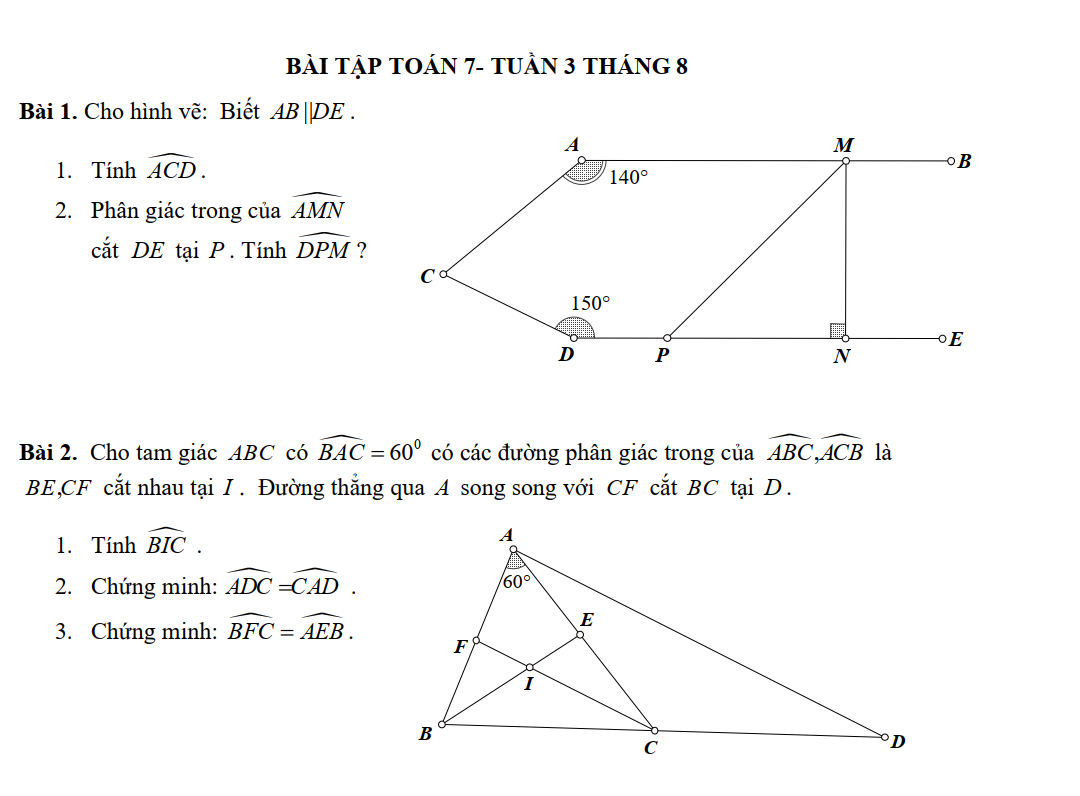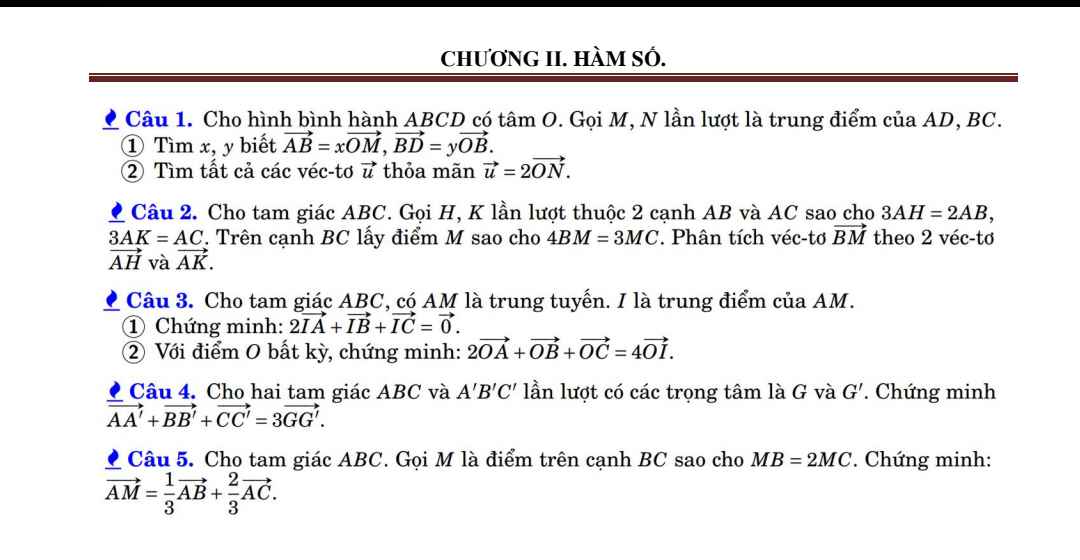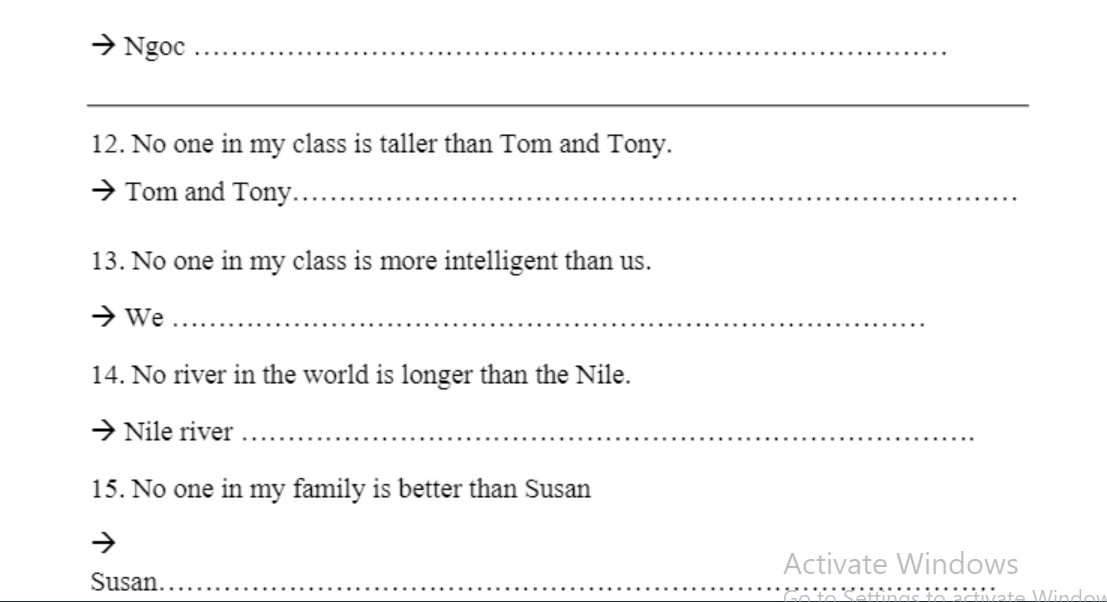Các bạn giúp mình các bt ở dưới nha 9h tối nay mình phải nộp rồi.

Những câu hỏi liên quan
các bạn giúp mình nhanh nha tối nay là mình phải nộp rồi:
(2x-2)mũ 2=16
(2x-2)2 = 16
(2x-2) = 4 vì 4 x 4 = 16
2x = 4 + 2
2x = 6
x = 6 : 2
x = 3
Đúng 0
Bình luận (0)
(2x - 2)2 = 16
=> (2x - 2)2 = 42 = (-4)2
=> \(2x-2\in\left\{4;-4\right\}\)
=> \(2x\in\left\{6;-2\right\}\)
=> \(x\in\left\{3;-1\right\}\)
Vậy \(x\in\left\{3;-1\right\}\)
Đúng 0
Bình luận (0)
\(\left(2x-2\right)^2=16\)
\(\Leftrightarrow\orbr{\begin{cases}2x-2=4\\2x-2=-4\end{cases}}\Leftrightarrow\orbr{\begin{cases}2x=6\\2x=-2\end{cases}\Leftrightarrow\orbr{\begin{cases}x=3\\x=-1\end{cases}}}\)
Đúng 0
Bình luận (0)
Giúp mình vs tối nay mình phải nộp rồi!!Mình cám ơn trước nha!!!
Câu 1:
1: \(\overrightarrow{OM}=\dfrac{\overrightarrow{OA}+\overrightarrow{OD}}{2}=\dfrac{\overrightarrow{BO}+\overrightarrow{OA}}{2}=\dfrac{\overrightarrow{BA}}{2}=-\dfrac{1}{2}\overrightarrow{AB}\)
\(\Leftrightarrow x=-\dfrac{1}{2}\)
\(\overrightarrow{BD}=2\cdot\overrightarrow{BO}=-2\cdot\overrightarrow{OB}\)
nên y=-2
2: \(2\cdot\overrightarrow{ON}=\overrightarrow{OB}+\overrightarrow{OC}=\overrightarrow{DO}+\overrightarrow{OC}=\overrightarrow{DC}=\overrightarrow{AB}\)
Vậy: Các vecto u thỏa mãn là vecto DC và vecto AB
Đúng 0
Bình luận (0)
Viết đoạn văn về dân tộc Tày bằng tiếng Anh
Mong các bạn giúp mình cần gấp ạ =)) (tối nay phải nộp rồi àm mình bí quá xin cảm ơn mấy bạn <3)
The Tay, with local groups Pa dí, Thổ, Ngan, Phén, Thu Lao, is an ethnic group of 54 ethnic groups in Viet Nam. Tay people speak Tay, a Tai dialect of the Tai-Kadai language. Tay people live mainly in lowland areas of northern Vietnam. The Tay was previously known as the Tho (although this name is now used to refer to a different ethnic group, see Turks). Tay people have the second largest population in Vietnam. Tay people, Nung have a close relationship with the Choang people in China.Tay people mainly reside in the northern midland and mountainous provinces (1,400,519 people in 1999). In addition, in the recent time, the Tay also migrated to some provinces in the Central Highlands like Dak Lak and Lam Dong.The Tay are usually at the foot of the mountain or along the stream. The name is often referred to by the name of hills, fields, rivers. Each village has 15 to 20 houses. Large villages divided into many small villages.Tay dressed in indigo. Traditional Tay costumes are made from self-made cotton yarn, dyed indigo on men's and women's clothes, almost without decorative pattern. Tay clothing can be considered one of the simplest outfits of 54 ethnic groups. The costume is simple but meaningful.Then singing, singing, singing sli are used in various activities, popular folk songs of the Tay. Musical instruments such as the Micro, Shake. Chess is an instrument that is present in all spiritual activities of the Tay, such as soul in the folk dance of the Tay. In this life, the sex acts as a means of communicating bold identity.Traditional houses are usually on stilts, lands and roofs with grass and some border areas have defense types. In the house to distinguish male rooms outside, women in the chamber. Most popular are 3-room, 2-roofed houses (no chop), logs of land or bushes, surrounding woods, roofs of grass, picturesque Tay people settle in groups of about 15 to 20 households. Tay people worship ancestors and animals. The Tay ancestors' altar is placed in the middle of the house and made into a private space and revered. Pregnant women and their newborns are not allowed to sit or lie on chairs or beds in front of the altar. In the Tay religion, the most important feast day of the Tay people is usually the last day of the lunar month.The life of the Tay is often associated with nature, so the food and foodstuff of the Tay people are products obtained from production activities in areas with forests, rivers, streams and hills surrounding. Some famous dishes are: sticky egg rolls, sticky rice balls, sour bamboo shoots, stigma.
Đúng 1
Bình luận (0)
The Tay, with local groups Pa dí, Thổ, Ngan, Phén, Thu Lao, is an ethnic group of 54 ethnic groups in Viet Nam. Tay people speak Tay, a Tai dialect of the Tai-Kadai language. Tay people live mainly in lowland areas of northern Vietnam. The Tay was previously known as the Tho (although this name is now used to refer to a different ethnic group, see Turks). Tay people have the second largest population in Vietnam. Tay people, Nung have a close relationship with the Choang people in China.Tay people mainly reside in the northern midland and mountainous provinces (1,400,519 people in 1999). In addition, in the recent time, the Tay also migrated to some provinces in the Central Highlands like Dak Lak and Lam Dong.The Tay are usually at the foot of the mountain or along the stream. The name is often referred to by the name of hills, fields, rivers. Each village has 15 to 20 houses. Large villages divided into many small villages.Tay dressed in indigo. Traditional Tay costumes are made from self-made cotton yarn, dyed indigo on men's and women's clothes, almost without decorative pattern. Tay clothing can be considered one of the simplest outfits of 54 ethnic groups. The costume is simple but meaningful.Then singing, singing, singing sli are used in various activities, popular folk songs of the Tay. Musical instruments such as the Micro, Shake. Chess is an instrument that is present in all spiritual activities of the Tay, such as soul in the folk dance of the Tay. In this life, the sex acts as a means of communicating bold identity.Traditional houses are usually on stilts, lands and roofs with grass and some border areas have defense types. In the house to distinguish male rooms outside, women in the chamber. Most popular are 3-room, 2-roofed houses (no chop), logs of land or bushes, surrounding woods, roofs of grass, picturesque Tay people settle in groups of about 15 to 20 households. Tay people worship ancestors and animals. The Tay ancestors' altar is placed in the middle of the house and made into a private space and revered. Pregnant women and their newborns are not allowed to sit or lie on chairs or beds in front of the altar. In the Tay religion, the most important feast day of the Tay people is usually the last day of the lunar month.The life of the Tay is often associated with nature, so the food and foodstuff of the Tay people are products obtained from production activities in areas with forests, rivers, streams and hills surrounding. Some famous dishes are: sticky egg rolls, sticky rice balls, sour bamboo shoots, stigma.
THAM KHẢO
Đúng 0
Bình luận (0)
The Tay, with local groups Pa dí, Thổ, Ngan, Phén, Thu Lao, is an ethnic group of 54 ethnic groups in Viet Nam. Tay people speak Tay, a Tai dialect of the Tai-Kadai language. Tay people live mainly in lowland areas of northern Vietnam. The Tay was previously known as the Tho (although this name is now used to refer to a different ethnic group, see Turks). Tay people have the second largest population in Vietnam. Tay people, Nung have a close relationship with the Choang people in China.Tay people mainly reside in the northern midland and mountainous provinces (1,400,519 people in 1999). In addition, in the recent time, the Tay also migrated to some provinces in the Central Highlands like Dak Lak and Lam Dong.The Tay are usually at the foot of the mountain or along the stream. The name is often referred to by the name of hills, fields, rivers. Each village has 15 to 20 houses. Large villages divided into many small villages.Tay dressed in indigo. Traditional Tay costumes are made from self-made cotton yarn, dyed indigo on men's and women's clothes, almost without decorative pattern. Tay clothing can be considered one of the simplest outfits of 54 ethnic groups. The costume is simple but meaningful.Then singing, singing, singing sli are used in various activities, popular folk songs of the Tay. Musical instruments such as the Micro, Shake. Chess is an instrument that is present in all spiritual activities of the Tay, such as soul in the folk dance of the Tay. In this life, the sex acts as a means of communicating bold identity.Traditional houses are usually on stilts, lands and roofs with grass and some border areas have defense types. In the house to distinguish male rooms outside, women in the chamber. Most popular are 3-room, 2-roofed houses (no chop), logs of land or bushes, surrounding woods, roofs of grass, picturesque Tay people settle in groups of about 15 to 20 households. Tay people worship ancestors and animals. The Tay ancestors' altar is placed in the middle of the house and made into a private space and revered. Pregnant women and their newborns are not allowed to sit or lie on chairs or beds in front of the altar. In the Tay religion, the most important feast day of the Tay people is usually the last day of the lunar month.The life of the Tay is often associated with nature, so the food and foodstuff of the Tay people are products obtained from production activities in areas with forests, rivers, streams and hills surrounding. Some famous dishes are: sticky egg rolls, sticky rice balls, sour bamboo shoots, stigma.
Đúng 0
Bình luận (0)
20ha2=.... dam2
5cm2=......mm2
13km2=.....ha
300m2=.....dam2
2100dam2=.....hm2
900mm2=......cm2
38m2 25dm2=.....dm2
15dm2 9cm2=.....cm2
10cm2 6mm2=.....mm2
Các bạn giúp mình với nha! Tối nay mình phải nộp rồi!
20ha=2000dam2
5cm2=500mm2
13km2=1300ha
300m2=3dam2
2100dam2=21hm2
900mm2=9cm2
38m2, 25dm2=3825dm2
15dm2 9cm2=1509cm2
10cm2 6mm2=1006mm2
Có bạn nào biết làm thì giúp mình nha mình đang cần gấp 9 giờ tối hôm nay mình phải nộp rồi nếu được thì mình cảm ơn rất rất nhiều
Bài 1:
1) Kẻ tia Cx//AB//DE
Ta có: Cx//AB
\(\Rightarrow\widehat{BAC}+\widehat{ACx}=180^0\)(2 góc trong cùng phía)
\(\Rightarrow\widehat{ACx}=180^0-\widehat{BAC}=180^0-140^0=40^0\)
Ta có: Cx//DE
\(\Rightarrow\widehat{xCD}+\widehat{CDE}=180^0\)( 2 góc trong cùng phía)
\(\Rightarrow\widehat{xCD}=180^0-\widehat{CDE}=180^0-150^0=30^0\)
\(\Rightarrow\widehat{ACD}=\widehat{ACx}+\widehat{xCD}=40^0+30^0=70^0\)
2) Ta có AB//DE(gt)
Mà DE⊥MN
=> AB⊥MN =>\(\widehat{AMN}=90^0\Rightarrow\dfrac{1}{2}\widehat{AMN}=45^0\Rightarrow\widehat{AMP}=45^0\) (do MP là tia phân giác \(\widehat{AMN}\))
Ta có AB//DE
=> \(\widehat{AMP}+\widehat{DPM}=180^0\) (2 góc trong cùng phía)
\(\Rightarrow\widehat{DPM}=180^0-\widehat{AMP}=180^0-45^0=135^0\)
Đúng 2
Bình luận (1)
Xét tam giác BIC có:
a)\(\widehat{BIC}=180^0-\left(\widehat{IBC}+\widehat{ICB}\right)=180^0-\left(\dfrac{\widehat{ABC}}{2}+\dfrac{\widehat{ACB}}{2}\right)=180^0-\dfrac{180^0-\widehat{BAC}}{2}=180^0-\dfrac{180^0-60^0}{2}=120^0\)
b) Ta có: FC//AD(gt)
\(\Rightarrow\left\{{}\begin{matrix}\widehat{FCB}=\widehat{ADC}\\\widehat{CAD}=\widehat{ACF}\end{matrix}\right.\)
Mà \(\widehat{FCB}=\widehat{ACF}\)(CF là tia phân giác \(\widehat{ACB}\))
\(\Rightarrow\widehat{ADC}=\widehat{CAD}\)
Đúng 1
Bình luận (1)
c) Xét tam giác BFI có:
\(\widehat{BFC}+\widehat{ABI}=\widehat{BIC}=120^0\left(1\right)\)(tính chất góc ngoài tam giác)
Xét tam giác ABE có:
\(\widehat{BAC}+\widehat{AEB}+\widehat{ABI}=180^0\)(tổng 3 góc trong tam giác)
\(\Rightarrow\widehat{AEB}+\widehat{ABI}=180^0-\widehat{BAC}=180^0-60^0=120^0\left(2\right)\)
Từ \(\left(1\right),\left(2\right)\Rightarrow\widehat{BFC}=\widehat{AEB}\)
Đúng 1
Bình luận (2)
Xem thêm câu trả lời
Giúp mình vs tối nay mình phải nộp rồi😭😭😭, mình cám ơn trước nha!!!
Câu 1:
1: \(\overrightarrow{OM}=\dfrac{\overrightarrow{OA}+\overrightarrow{OD}}{2}=\dfrac{\overrightarrow{BO}+\overrightarrow{OA}}{2}=\dfrac{\overrightarrow{BA}}{2}=-\dfrac{1}{2}\overrightarrow{AB}\)
\(\Leftrightarrow x=-\dfrac{1}{2}\)
\(\overrightarrow{BD}=2\cdot\overrightarrow{BO}=-2\cdot\overrightarrow{OB}\)
nên y=-2
2: \(2\cdot\overrightarrow{ON}=\overrightarrow{OB}+\overrightarrow{OC}=\overrightarrow{DO}+\overrightarrow{OC}=\overrightarrow{DC}=\overrightarrow{AB}\)
Vậy: Các vecto u thỏa mãn là vecto DC và vecto AB
Đúng 1
Bình luận (0)
giúp mình với,mình đang cần gấp 9h tối nay mình phải nộp bài rồi
3. Nêu cảm nhận của em khi đọc đoạn thơ sau
Cửa sổ là mắt của nhà
Nhìn lên trời rộng , nhìn ra sông dài
Cửa sổ là bạn của người
Giơ lưng che cả khoảng trời gió mưa
Cửa sổ còn biết làm thơ
Tiếng chim cùng ánh nắng ùa vào xem.
mình sẽ tk cho tất cả các bạn trả lời câu hỏi của mình
Đọc tiếp
giúp mình với,mình đang cần gấp 9h tối nay mình phải nộp bài rồi
3. Nêu cảm nhận của em khi đọc đoạn thơ sau
Cửa sổ là mắt của nhà
Nhìn lên trời rộng , nhìn ra sông dài
Cửa sổ là bạn của người
Giơ lưng che cả khoảng trời gió mưa
Cửa sổ còn biết làm thơ
Tiếng chim cùng ánh nắng ùa vào xem.
mình sẽ tk cho tất cả các bạn trả lời câu hỏi của mình
Qua đoạn văn trên, em cảm thấy cửa sổ là thứ mà không thể thiếu trong 1 ngôi nhà, cửa số giúp thoáng mát, giúp ta có thể hóng gió, trông xa xa còn có thể ngắm khung cảnh làng quê. (viết ngắn ngắn thôi nhé, viết dài ra loằng ngoằng đấy bạn) tk cho mình đy
tác giả đã nói lên ý nghĩa đẹp đẽ của ngôi nhà thân thương: giúp em được sống gần gũi, chan hòa với thiên nhiên, đất nước ("Nhìn lên trời rộng, nhìn ra sông dài"), luôn sẵn sàng giúp em vượt qua khó khăn, thử thách trong cuộc sống ("Giơ lưng che cả khoảng trời gió mưa")
Đoạn thơ trên nhà thơ đã sử dụng biện pháp nghệ thuật nổi bật là so sánh và nhân hóa. Bằng biện pháp nghệ thuật đó tác giả đã nói lên ý nghĩa đẹp đẽ của ngôi nhà thân thương: giúp em được sống gần gũi, chan hòa với thiên nhiên, đất nước ("Nhìn lên trời rộng, nhìn ra sông dài"), luôn sẵn sàng giúp em vượt qua khó khăn, thử thách trong cuộc sống ("Giơ lưng che cả khoảng trời gió mưa")
Tìm x :
280 - x . 9 = 450
Mong các bạn giải giúp mình với ạ! Tối mình phải nộp bài rồi. Nếu đề sai các bạn sửa chữa giúp mình nhé. Chúc các bạn học tốt ạ
280 - x.9 = 450
x.9 = 280 - 450
x.9 = -170
x= -170/9
Đúng 0
Bình luận (0)
 mmoij người ơi giải giúp mình với tới 9h hôm nay là mình phải nộp cho cô rồi
mmoij người ơi giải giúp mình với tới 9h hôm nay là mình phải nộp cho cô rồi


























